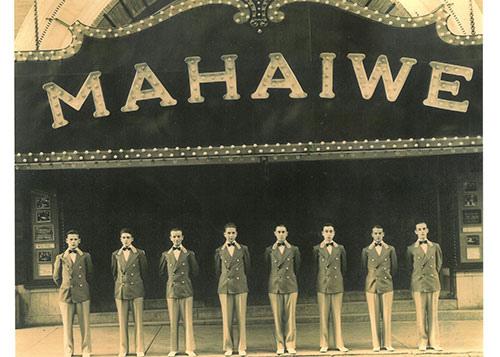Mahaiwe Ushers
Things were much more formal in the first half of the 20th century and ushers at the historic Mahaiwe Theater worked in uniforms. Here, left to right, in a 1939 image from the Raifstanger family archives, ushers William Molley, Joseph Liss, Edmund Kubik, Maurice Bradenton, David Drumm, Joseph McHugh, Robert Cuenin and John Cronin pose in front of the original—since replaced—marquee.
The picture was probably taken in May or June 1939, just after the release of Confessions of a Nazi Spy starring Edward G. Robinson, an advertisement for which appears on the front of the building. It was the first explicitly anti-Nazi film produced by a major Hollywood studio, only four months before the beginning of World War II.
By the time this picture was taken, the Mahaiwe already had a long and illustrious history. In 1904, a coalition of businessmen orchestrated construction of the Mahaiwe Theater and encompassing Mahaiwe Block. Designed by architect Joseph McArthur Vance, the structure replaced an earlier corner building on Castle and Main streets that burned in 1901.

In 1905, the theater officially opened with live performances. It had a capacity of 1,000 patrons, who watched performances by such celebrities as John Philip Sousa, Buster Keaton and other vaudeville acts. Silent films were first shown in 1914, followed by “talkies” in 1929. An early projectionist filed a film patent from the theater in 1914.
In the 1930s the theater saw its first renovation, downsizing to 750 seats, and shifted its focus to movies. Earl B. Raifstanger Sr managed the theater for several decades and long-term manager Al Schwartz managed it through the latter part of the 20th century. The theater has continuously run programs since its opening 120 years ago.
The theater faced prospective demolition and redevelopment when a cinema chain acquired it in 1988. However, in 1995, the Mahaiwe gained protection under Great Barrington’s Downtown Historic District. In 2003 renovation under its present leadership began. Work was completed in time for a Centennial Celebration in 2005 with the launch of year-round arts programming.
Today, the Mahaiwe Performing Arts Center sits in the heart of the Downtown Great Barrington Cultural District, anchoring a bustling arts scene in town. It was selected as one of only 29 cultural organizations across the Commonwealth to participate in the 2018-2024 Barr-Klarman Massachusetts Arts Initiative.

